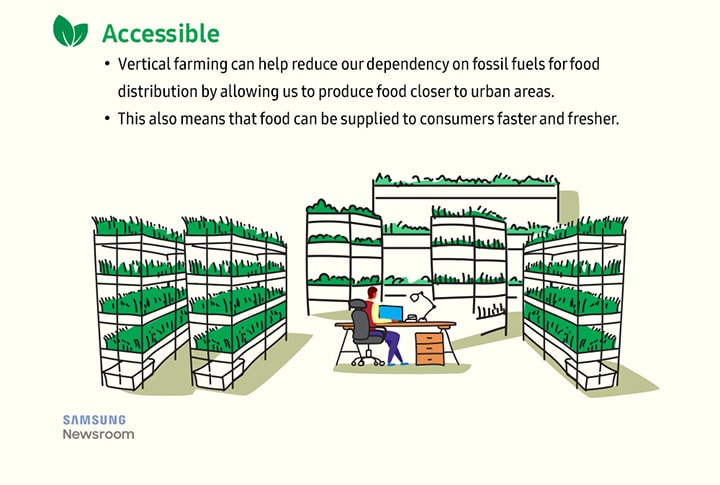[Going Green 1] Introducing Healthy Vertical Farming
![[Going Green 1] Introducing Healthy Vertical Farming](https://image.led.samsung.com/image/samsung/p6/led/insights/insights-detail-26/insights-detail-26-thumb.jpg?$ORIGIN_JPG$)
Agricultural innovations are essential for feeding our ever-growing global population. Especially these days, as industrialization and global warming continue to negatively affect soil fertility and reduce the amount of arable land.
According to the United Nations, the world’s population is set to reach 9.8 billion by 2050. Such a large population would require approximately 1.7 times more food than is available now.
One potential solution for addressing the world’s need for more healthy and abundant food production is vertical farming – a process that’s growing increasingly popular in places like Europe, the U.S. and Japan, and involves food being grown indoors in vertically stacked layers.

What makes vertical farming such an efficient and viable means to produce food are the facts that it (1) saves space, and (2) allows farmers to grow crops all year round, regardless of climate or season.
Interest in vertical farming has been rapidly growing in recent years. Market research firm MarketsandMarkets predicts that the global market for vertical farming will be worth $18.4 billion by 2022, which is twice as much as the market was valued in 2016 ($9 billion).






Innovating for a Greener Future
The movement for healthy, sustainable food production is spreading across the world, and Samsung is committed to driving innovation in this area.
Last spring, Samsung announced the launch of a wide range of horticulture LED offerings that produce a broad spectrum of light to support healthy plant growth. On April 23, Samsung introduced an update to the LM301H, which features the highest photon efficacy among today’s mid-power white LED packages. The company has also revealed a number of exciting innovations designed to make it easy for consumers to grow and enjoy fresh, healthy vegetables from the comfort of their home.
Samsung also made waves at this year’s Kitchen & Bath Industry Show in Las Vegas with its all-new Chef Garden technology, which offers a simple, environmentally friendly way to grow food at home. Chef Garden integrates seamlessly with Samsung’s next-generation Family Hub refrigerator, and automatically regulates light wavelengths to enable users to grow and enjoy fresh, pesticide-free fruit and vegetables all year round.

“There is a growing interest in healthy food,” said Chohui Kim of Samsung Electronics’ LED Technology Center. “Horticulture LED is playing a key role in vertical farming and indoor crop cultivation, and we are looking to expand its applications in various fields.”
The second part of Samsung Electronics’ “Going Green” series will highlight technology trends and the company’s efforts regarding eco-friendly crop cultivation in detail.


 Copyright ⓒ 1995-2023 SAMSUNG All Rights reserved.
Copyright ⓒ 1995-2023 SAMSUNG All Rights reserved.